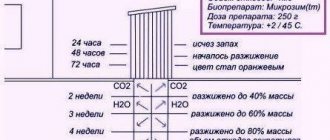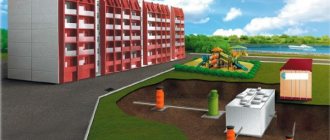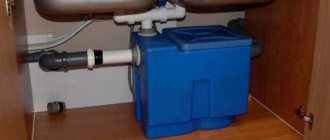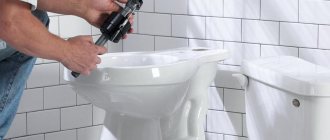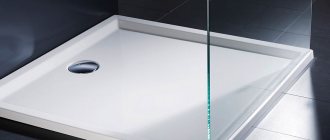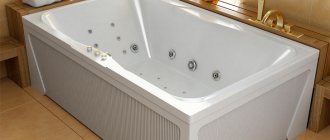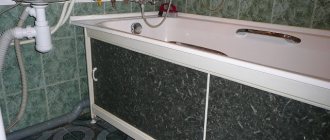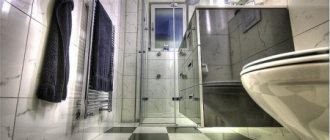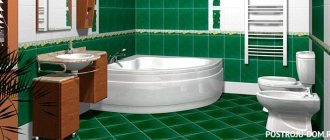Types of heated towel rails based on operating principle
There are three types of dryers installed in the bathroom:
- water device;
- powered by electricity;
- combined model.
To choose which heated towel rail to use in the bathroom, you need to study the operating principle of each type.
Water type device
To make a water heated towel rail, copper, chrome-plated brass, stainless steel, black steel, and nickel-plated are used.
The priority is to use stainless steel. This is explained by the fact that this material can withstand increased surges in water pressure.
The description of the operating principle of the water model resembles the operation of a heating battery: hot water is supplied from the main line to the radiator. Then it moves through the pipes of the drying structure. At this moment, heat is released into the room. The liquid enters the water supply or heating system through the return pipe.
The advantages of the water model only confirm the correctness of its choice:
- after installation, electricity bills will not increase, since the dryer is not connected to the electrical network;
- The installation itself is simple and does not require additional measures (grounding, special moisture-resistant sockets);
The biggest problem faced by owners of a water structure powered by a heating network is the suspension of its use during the non-heating season.
Electric model
The heating element is a cable or heating element, which are located inside the radiator. The coolant is water or antifreeze if a heating element is installed inside. When there is a cable in the pipes, the radiator is without liquid. Electric heated towel rails in the bathroom are equipped with a thermostat and rheostat. These devices are used to regulate the temperature inside the structure.
Such models are either mounted on the wall or installed on the floor using legs. Different materials are used for manufacturing, but stainless steel coated with chrome is recognized as the best.
The dryer runs on electricity supplied to the heating element. The coolant is the liquid inside the pipes. It is heated by heating elements to 60 oC, 70 oC. The heating level is maintained with the help of heating elements, or with the help of additional devices mentioned above.
What coolants are used
There is no need to buy coolant separately for a water heated towel rail. Water is used that is supplied to the pipes automatically when the tap is running or when the heating is connected.
If you decide to make an electric heated towel rail with your own hands, you can use distilled water, oil or antifreeze.
The advantage of the first option is its low cost and availability. The disadvantages are related to the properties of water. When the temperature changes, the liquid expands, which can lead to pipe rupture. To prevent leakage, install the boiler. It will have to be installed separately.
The oil retains its properties even at critical temperatures. You can choose an option that protects against corrosion. The disadvantage of the coolant is the high cost of refilling the system.
Antifreeze is most often used for metal dryers. Such liquids protect the material from corrosion and prevent surface contact with air.
Metal pipes for the manufacture of a water device
Calculations of the power of the device are made based on the area of the room where the DIY heated towel rail will be installed, air humidity, and the presence of ventilation. The recommended thermal energy level is 150 watts per 1 m2 of room.
The ability of the device to heat the required area of the room depends on the height and width of the device being manufactured. This dependence is reflected in the table.
| Device dimensions: height/width, m | Room in m2 |
| 0,5/0,4; 0,5/0,5; 0,5/0,6 | From 4.5 to 6.0 |
| 0,6/0,4; 0,6/0,5; 0,6/0,6 | From 6.0 to 8.0 |
| 0,8/0,4; 0,8/0,5; 0,8/0,6 | From 7.5 to 11.0 |
| 1,0/0,4; 1,0/0,5; 1,0/0,6 | From 9.5 to 14.0 |
| 1,2/0,4; 1,2/0,5; 1,2/0,6 | From 11.0 to 17.0 |
For example, for rooms with the most common area of 4.5-6.0 m2, a model with dimensions of 0.53/0.5 meters indicated in the preliminary drawing is mounted.
To install a heated towel rail, the following materials are purchased:
- metal pipe with a cross section of 3.2/0.2 cm, length 300 cm;
- pipe outlet at an angle with a cross section of 3.2/0.2 cm - the quantity is individual for each snake design;
- “American” and bushings for it - 4 pieces each (depending on the model);
- fastening elements – 4 pcs. (depending on the model);
- number of decorative washers for fastening – 4 pcs.;
- M8 pin;
- M8 nut for the stud.
Without the selection of tools, installation will be difficult:
- welding tool;
- set of electrodes;
- argon;
- Bulgarian;
- metal discs;
- felt and grinding wheels;
- felt-tip pen, tape measure.
Stages of manufacturing a heated towel rail from metal pipes
The algorithm for performing work on the manufacture of a dryer from metal pipes is described as an example on the model from the drawing:
- Pipes of the required length are measured.
- The required pieces are cut with a grinder.
- Pipe sections are ground and polished using circles.
- Pieces of pipes with corner bends are connected into a single structure.
- The structure blank is connected to the bends.
- Welding seams are ground until the surface of the structure is smooth.
- Fastening elements are installed.
- The free ends are connected to the riser branches using “American” connectors.
- Checking all connections and final sanding of the entire surface.
Algorithm for creating an electrical model
The creation of a model powered by electricity is based on the design of a water device. Therefore, the work begins with its acquisition. In addition you will need:
- electric heating element for the device (power not less than 110 W), with an external threaded connection of ½ inch, with a temperature controller;
- plugs (external thread ½ inch) – 2 pieces;
- Mayevsky tap (external thread ½ inch) – 1 piece;
- for sealing tow joints.
Electric heated towel rails are most often found in the form of a “ladder” model.
- More often, the left rack is chosen, with plugs screwed in at the top and bottom;
- then on the right side, below, an electric heating element is inserted into the rack;
- the structure is filled with water through the upper open hole;
- after the water has occupied all the free space inside, the hole is closed with a Mayevsky tap;
- By inserting the plug into the socket, the work performed is monitored.
The last step in working with an electrical device is to mount it on the wall.
Combined model and its manufacture
A water heated towel rail is used as a basic design, so it is purchased or made according to your own drawing.
Materials required for assembly:
- Heating element, power from 150 W;
- one Mayevsky crane;
- two water valves with double threads for internal and external connections, ½ inch each;
- FUM tape or tow;
- adjustable wrench.
Making a combined “ladder”:
- one riser is selected, water taps are screwed into it from above and below;
- the upper hole of the other riser is closed with a Mayevsky tap;
- a heating element is inserted into the lower hole.
Based on knowledge of the fundamental differences in the operation of each type of heated towel rail, a model is selected that suits your wishes. At the preparatory stage, attention is paid to measurements and creating a drawing of the future model. At the time of assembly, it is important to properly assemble the structure and check all connections for leaks. To assemble a heated towel rail yourself, you will need patience and accuracy in your work.
Most models are made of stainless steel, and this requires certain costs. If you have skills in working with plumbing, then a DIY heated towel rail made from polypropylene pipes will be an economical model. For manufacturing, a simple design with a minimum number of connecting points is selected.
External signs of normal quality
Something else worth paying attention to is the quality of the seams. The first sign of a high-quality seam is that it is smooth and uniform. Without cavities, strong protrusions and depressions. If you pre-select a manufacturer, find information about exactly how, on what equipment, and in what environment welding takes place. This is especially critical for stainless steel. It must be cooked in a protective (usually argon) environment so that the alloying metals do not burn out. If you weld stainless steel using the usual method, in an atmosphere with oxygen, the “stainless” properties in the weld area are not preserved. Then it is the seam that begins to rust and leak. Therefore, manufacturers usually indicate exactly how stainless steel is welded.
There are models with folding parts
It is also worth paying attention to the quality of painting, chrome plating, and nickel plating. There should be no defects, unpainted areas, or foreign inclusions. Only if all these conditions are met can you think about buying.
Technical characteristics of polypropylene pipes
The use of the material is justified by its technical characteristics:
- high abrasion resistance;
- the structure can withstand and does not deform under the influence of hot water. Integrity is maintained at liquid temperatures from 120 °C to 140 °C;
- the material does not rust;
- the smooth surface does not allow debris particles to accumulate inside the pipes;
The poor frost tolerance of the material is not taken into account when using it to make a dryer.
A polypropylene pipe will last for half a century if the pressure is up to 6 atmospheres and the temperature is 75 °C.
If we compare a coil made of metal and polypropylene, the latter will lose in terms of temperature on the surface of the pipe. Its thermal conductivity is 2 units lower than a metal pipe.
For connection to the plumbing system and central heating, PP80 grade material is used.
The propylene structure is assembled without welding. This is an advantage of installation work with this material. On the other hand, if there is no experience in installing compression fittings or working with a soldering iron for polypropylene, then the structure will leak at the joints.
The required size of a dryer made of polypropylene pipes is selected, as for stainless steel, according to a table with data on the area of the room. On the drawing it will be possible to count the number of connecting nodes.
Additional selection criteria
An electric heated towel rail is not such a complicated device and it doesn’t have many characteristics. When choosing, pay attention to the following parameters:
- Maximum surface heating temperature. Usually it is 50-65°C.
- Electrical cord length. It is clear that the socket to turn on the device should be nearby. But the cord length is less than 1 m, sometimes it may not be enough. The cord, of course, can be replaced. But is it worth buying a product that does not meet the minimum requirements?
If you don't like the cord sticking out, you can make a hidden connection
Pay attention to the quality of the cord itself and the plug. The cord must be elastic and flexible. The connection to the body and plug must be well protected and secured. The electrical plug itself must have a grounding contact and the body is made of good plastic.

